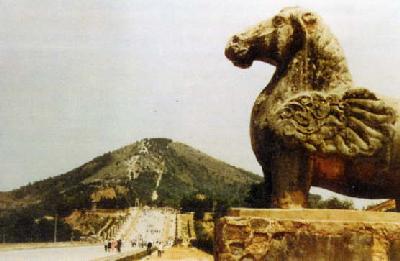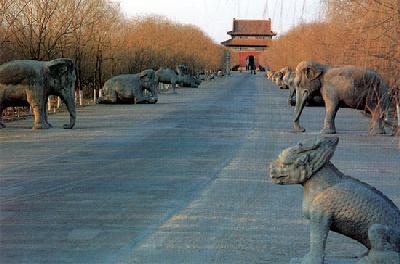| Art Q&A > Architecture |
|
|
Mausoleum and Culture of Yin and Yang
The Confucians placed special emphasis on filial piety in providing a stable foundation for maintaining the patriarchal social order with blood lineage as the bond. They argued that, filial piety applied not only during the lifetime of the family elders but also after their death. The dead were treated exactly the same as the living, through sacrifices, worship and reporting everything that happened. Such activities were directed to the ancestors' memorial tablets. After their death, the tomb is their residence in another world, called "Yin (negative) residence" to which full, and even more attention, should be paid than when the person occupied the "Yang (positive) residence". This was even more true in the case of imperial mausoleums.
The graves of the monarch in ancient times were particularly high and large, and called either a "mausoleum" or "imperial tomb". The original meaning of "mausoleum" was a high and big mountain. The Tang Dynasty (618-907) witnessed the second climax in the construction of mausoleums in China, following the Qin and Han dynasties (221BC-220AD). Great achievements were made in the combination of natural environment during the Tang Dynasty, and the vast scene was given strong memorial character. There was a distinguishing feature in the Tang Dynasty mausoleum, in that the entire mausoleum district was modeled on the capital city.
After the Manchu people entered Shanhaiguan, there were two groups of tombs in Hebei's Zunhua and Yixian counties, because they were located separately in the east and west of Beijing, hence the name of East Mausoleum and West Mausoleum. Whether in terms of the site selection principle or concrete layout, they are similar to, but developed somewhat differently from and more gorgeous than, the Ming Tombs£®
Chinese mausoleum is a comprehensive art combined of architecture, sculpture, painting, and natural scenery. Throughout the history, the layout of mausoleums falls into three types:
1. Built along high mountains and large rivers, tall trees and huge rocks, to give prominence to the loftiness and dignity of the imperial authority, as well as a strong memorial character. This type is represented by the Qinshihuang Mausoleum in Lintong, Shaanxi.
2. Built with a Sacred Way as an axes. Take the Tang Qianling Mausoleum for example, built at the foot of the mountains, it has a long Sacred Way on the axes with various stone carvings on both sides, such as stone archway, Shixiangsheng, and stone inscriptions, etc.
3. The method of group layout of the Ming and Qing tombs. |
||||||
All rights reserved. Reproduction of text for non-commercial purposes is permitted provided that both the source and author are acknowledged and a notifying email is sent to us. |
||||||
 |

